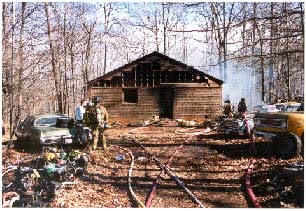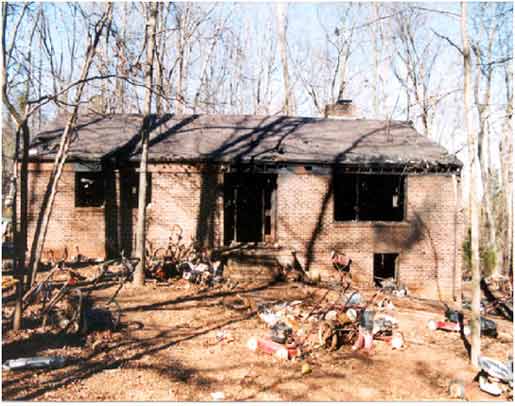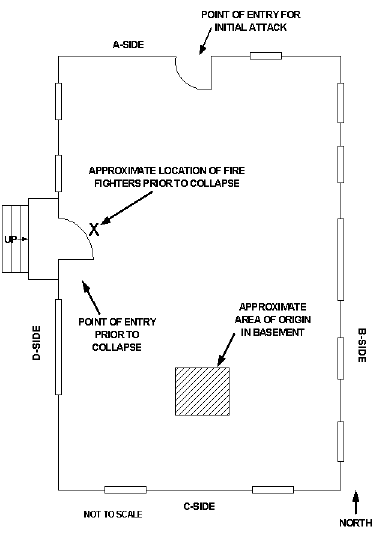

One Career Fire Fighter Dies and a Captain Is Hospitalized After Floor Collapses in Residential Fire - North Carolina
SUMMARY
On March 4, 2002, a 22-year-old male career fire fighter (the victim) was injured and subsequently died and a 25-year-old male Captain was injured when the floor collapsed while they were fighting a residential fire. The Captain was transported by ambulance to an area hospital where he was admitted overnight for first- and second-degree burns. The victim was conscious and was transported by medical helicopter to a State medical center where he died 2 days later. NIOSH investigators concluded that, to minimize the risk of similar occurrences, fire departments should

Site of the incident
INTRODUCTION
On March 4, 2002, a 22-year-old male career fire fighter (the victim) and a 25-year-old male Captain were seriously injured after the floor collapsed while they were fighting a residential fire. The victim died from his injuries on March 6, 2002. On March 7, 2002, the U.S. Fire Administration (USFA) notified the National Institute for Occupational Safety and Health (NIOSH) of this fatality. On April 15-16, 2002, two safety and occupational health specialists from the NIOSH Fire Fighter Fatality Investigation and Prevention Program investigated the incident. NIOSH investigators interviewed the Chief and other officers and fire fighters involved in this incident, and reviewed copies of the fire department’s standard operating guidelines (SOGs), pictures of the incident scene, training records of the victim, reports completed by the County Fire Marshal’s Office, and the death certificate.
This combination department is comprised of 11 career and 45 volunteer fire fighters and serves a population of approximately 10,000 in an area of about 30 square miles. The 22-year-old victim had been a fire fighter for 6 years, 2 years of which were as a full-time career fire fighter in another department. He had been a volunteer and a part-time career fire fighter with the department involved in the incident for less than 1 year. The department requires all personnel to have a minimum of National Fire Protection Association (NFPA) Firefighter Level I certification, Emergency Medical Technician (EMT) I certification, and 40 hours per year refresher training. The victim had approximately 800 hours of fire-fighter training including NFPA Firefighter Level I & II, EMT, Hazardous Materials, Apparatus Operation, and Search & Rescue.
Structure
This was a single-family, one-story, wood frame structure (~1450 sq ft), with masonry veneer and a gable-style roof with asphalt shingles. It had a full basement and a wood main-beam center held up by spaced metal post jacks. The north end of the dwelling was at grade level; however, the grade sloped away along the east and west facades, fully revealing the basement at the south of the dwelling. In the basement there were three windows, two of the windows were on B-Side and one was on D-Side (Photo and Diagram). An overhead garage door was located on the southwest corner (C-Side) of the structure. According to the County Fire Marshal’s report and fire fighters at the scene, the exterior of the dwelling and the basement were cluttered with various gasoline-powered equipment such as lawnmowers and weedeaters.
INVESTIGATION
On March 4, 2002, at 1217 hours, Central Dispatch received calls from several motorists via cell phones reporting a structure fire. Note: According to the County Fire Marshal, it is believed that the owner of the home fought the fire for approximately 19 minutes before it was reported. Central Dispatch notified the department at approximately 1218 hours and they responded. At 1225 hours a Captain from one of the mutual-aid departments arrived on the scene in his personally owned vehicle (POV). He observed heavy fire conditions on the D-Side of the structure and heavy smoke coming from the side door (A-Side) (Diagram). He radioed Central Dispatch that it was a working fire, and he assumed Incident Command (IC). The IC asked the homeowner, who was standing in the yard, if anyone was still in the structure, and the homeowner replied no, only some animals. The IC walked around to the front door (D-Side) to perform a size-up and observed fire and smoke emitting from the basement window.
Between 1225 and 1231 hours the following apparatus and personnel arrived on the scene from several departments in this sequence:
Engine-M1 (Assistant Chief)
Ambulance (Assistant Chief, 1 Fire Fighter)
Engine-R1 (2 Fire Fighters)
Engine-1551 (2 Captains, 1 Fire Fighter, and the Victim)
Department Vehicle (Deputy Chief)
Engine-N1 (Chief, 1 FF)
Engine-2 (Chief)
At approximately 1227 hours, the Chief from Engine N1 and two officers and the victim from Engine 1551 arrived on the scene and asked the homeowner if anyone was in the home. Based upon the homeowner’s erratic behavior, the Captains and the victim from Engine 1551 assumed that the structure was still occupied.
The Captains and the victim from Engine 1551, along with other fire fighters on the scene, stretched a 1¾ hoseline to a side door (A-Side). An officer from the victim’s department reported to the side door (A-Side), where heavy smoke was showing, to oversee his crew. The two Captains from the victim’s department (one carrying a thermal imaging camera) the victim, and several other fire fighters made several attempts to enter the side door (A-Side) but were only able to go several feet into the room because of the heat, smoke, and debris.
At approximately 1231 hours, Engine 2 arrived on scene with a Chief. The Chief from Engine 2 approached the IC standing near the roadway on Side A, and told him he would assume the role of IC. The new IC told the Chief from Engine N1 to pull a second 1¾ hoseline and stretch it to the front door (D-Side) (Photo). The new IC walked up to the side door (A-Side); several fire fighters came out of the doorway and advised him of the conditions inside. At approximately 1233 hours the new IC told the two Captains from Engine 1551, the victim, and several fire fighters to bring the hoseline around to the front door (D-Side). Officers and fire fighters reported to NIOSH investigators that they saw smoke and fire through the basement window (D-Side). As reported by the County Fire Marshal, getting the hoselines around to D-Side was a difficult task due to the amount of debris in the yard and on the porch.
Another Captain from one of the departments arrived on the scene in his POV, reported to the front door (D-Side), and assisted with making a forcible entry. This Captain and a fire fighter proceeded to the roof to perform ventilation. Several fire fighters made an initial attack with a hoseline through the front door (D-Side); however, after getting approximately 5 feet inside, they came back out because they encountered a lot of heat and smoke, and debris on the floor. Note: As reported to NIOSH investigators, the debris on the floor consisted of a large volume of aerosol, oil, and paint cans.
The victim then took the nozzle on the hoseline followed by the two Captains from his department. After extinguishing some fire inside the doorway, they were able to make entry into the structure (D-Side). After crawling into the doorway approximately 5 feet, the Captain behind the victim on the hoseline told the victim to wait until roof ventilation was completed. The other Captain was still in the doorway on the porch, and a Chief and a fire fighter were staged on the porch with a second hoseline as a backup.
At this point, a basement window beside the front porch broke and fire began to blow outward (D-Side). A Deputy Chief with the victim’s department, who was standing at the bottom of the stairs to the porch, yelled to the crew inside to exit. The Captain at the door told the Captain in front of him on the hoseline that there was fire below. At approximately the same time, the officer and the fire fighter began making cuts on the D-Side of the roof felt the roof shake, and they quickly made their way off. Note: They were unable to perform complete ventilation; only a few cuts were made. At approximately 1236 hours, the Captain behind the victim on the hoseline felt the floor bounce and reached for the victim as the floor collapsed. Note: According to the County Fire Marshal’s office, the entire first floor of the structure and the contents collapsed into the basement. The origin and cause of the fire were determined to be a woodstove located approximately in the middle of the basement. Most of the structural studs of the first-floor walls were suspended in mid-air, and the floor joists had either collapsed or were burned away.
The Captain behind the victim fell into the basement and landed on some debris which placed him at about chest level to the doorway ,allowing him to pull himself up to the door ledge and crawl out onto the porch. He told the other Captain behind him on the porch that the victim was still inside. At approximately 1237 hours, a medical helicopter was requested.
Several rescue attempts were made by the officers and fire fighters, who could see the victim standing in the basement surrounded by fire and reaching up for assistance. The officers and fire fighters who had been on the hoselines pulled up the hose that had fallen into the basement and used it to spray water on the victim in an attempt to keep the fire away from him as they made several attempts to reach him. On a third attempt, the Captain who had been behind the victim on the hoseline was able to reach and lock arms with the victim and pull him closer to the door ledge so the victim would be able to stand on some debris in the basement. One Captain went for a ladder as the Captain that had made contact with the victim crawled back onto the porch. As the Captain crawled back onto the porch, he saw that the victim was standing on some debris and was reaching out for assistance. The officers and the fire fighters pulled the victim out into the yard.
At approximately 1238 hours, paramedics and a stretcher were requested to report to D-Side, and the IC ordered a defensive attack on the fire. At approximately 1254 hours, a medical helicopter arrived and transported the victim to a State medical center where he died 2 days later. The Captain who had been behind the victim on the hoseline was transported by ambulance to an area hospital where he was admitted overnight for treatment of first- and second-degree burns. Another Captain with the victim’s department was transported in a department vehicle to an area hospital where he received medical treatment for first- and second-degree burns.
CAUSE OF DEATH
The death certificate listed the cause of death as multi-organ failure; 80% total body surface burns.
RECOMMENDATIONS/DISCUSSION
Recommendation #1: Fire departments should ensure that each Incident Commander conducts a size-up of the incident before initiating fire-fighting efforts, after command is transferred, and continually evaluates the risk versus gain during operations at an incident. 1-6
Discussion: A proper size-up begins from the moment the alarm is received, and it continues until the fire is under control. Considerations for occupant rescue operations include information such as time of incident, length of time fire was burning before arrival, time fire was burning after arrival, the time occupants have for rescue (risk vs. gain), and type of attack. These are some of the most important pieces of information the Incident Commander must have. After it has been determined that the timeframe for the potential of occupant rescue has expired, the operation should become a recovery and all tactical efforts should be defensive.
Recommendation #2: Fire departments should ensure fire fighters are trained to recognize the danger of searching above a fire. 7
Discussion: The danger of searching above a fire is greatly influenced by the construction of the burning building. Of the five basic building construction types (fire resistive, noncombustible, ordinary construction, heavy timber, and wood-frame) the greatest danger to a fire fighter who must search above the fire is posed by wood frame construction. Vertical fire spread is more rapid in this type of structure. Flames may spread vertically and trap fire fighters searching above the fire in four ways: up the interior stairs, through windows (autoexposure), within concealed spaces, or up the combustible exterior siding. Extreme caution must be used in determining if the structural stability of the flooring system is adequate to continue fire fighter efforts or to facilitate the search.
Recommendation #3: Fire departments should ensure that an Incident Safety Officer independent from the Incident Commander is appointed. 1, 4, 8
Discussion: According to NFPA 1561, paragraph 4-1.1, "The Incident Commander shall be responsible for the overall coordination and direction of all activities at an incident. This shall include overall responsibility for the safety and health of all personnel and for other persons operating within the incident management system." Whereas the Incident Commander (IC) is in overall command at the scene, certain functions must be delegated to ensure adequate scene management is accomplished. According to NFPA 1500, paragraph 6-1.3, "As incidents escalate in size and complexity, the incident commander shall divide the incident into tactical-level management units and assign an incident safety officer to assess the incident scene for hazards or potential hazards." The incident safety officer (ISO), by definition is "an individual appointed to respond to or assigned at an incident scene by the incident commander to perform the duties and responsibilities specified in this standard. This individual can be the health and safety officer or it can be a separate function." According to NFPA 1521, paragraph 2-1.4.1, "An incident safety officer shall be appointed when activities, size, or need occurs." On-scene fire fighter health and safety is best preserved by delegating the function of safety and health oversight to the ISO. The ISO is appointed by the Incident Commander at each emergency scene. The duties of the ISO are to monitor the scene and report the status of conditions, hazards, and risks to the incident commander, to ensure that fire-fighter rehabilitation occurs and that the personnel accountability system is being used, and to monitor radio communications to ensure all areas of the scene are capable of communicating to incident command.
Recommendation #4: Fire departments should ensure that ventilation is closely coordinated with the fire attack. 6
Discussion: Chapter 10 of Essentials of Fire Fighting, 4th edition, states that, "ventilation must be closely coordinated with fire attack. When a ventilation opening is made in the upper portion of the building, a chimney effect (drawing air currents throughout the building in the direction of opening) occurs." Ventilation is necessary to improve a fire environment so that fire fighters can approach a fire with a hoseline for extinguishment. Only after a charged hoseline is in place ready for extinguishment is ventilation of windows and doors most effective. Command should determine if ventilation is needed and where ventilation is needed. The type of ventilation should be determined, based on evaluation of the structure and conditions on arrival. Decisions regarding ventilation should be communicated to all fire fighters on the scene.
Recommendation #5: Fire departments should ensure that a Rapid Intervention Team is established and in position immediately upon arrival. 9
Discussion: A Rapid Intervention Team (RIT) should respond to every major fire. The team should report to the officer in command and remain at the command post until an intervention is required to rescue a fire fighter (s) or civilians. The RIT should have all tools necessary to complete the job–e.g., a search rope, first-aid kit, and a resuscitator– including tools for use if a fire fighter becomes injured. The RIT will be ordered by the IC to complete any emergency searches or rescues. They will provide the suppression companies an opportunity to regroup and take a roll call instead of performing rescue operations. When the RIT enters to perform a search and rescue, they should have full cylinders on their SCBAs and be physically prepared. When a RIT team is used in an emergency situation, an additional RIT team should be put into place in case an additional emergency situation arises. This additional RIT team should be comprised of fresh, well-rested fire fighters.
Recommendation #6: Fire departments should ensure that adequate numbers of staff are available to operate safely and effectively. 8, 10
Discussion: NFPA 1720 recommends that an occupational safety and health program be provided to form the basis of protecting the health and safety of fire fighters in accordance with NFPA 1500, Standard on Fire Department Occupational Safety and Health Program.
As stated in NFPA 1720 (A.6.4.1.1) "It is recommended that a minimum acceptable fire company staffing level should be four members responding to any type of fire. The minimum acceptable staffing level for companies responding in high-risk areas should be five members responding or arriving with each engine company and six members responding or arriving with each ladder company. These recommendations are based on experience derived from actual fire and in-depth fire simulations and are the result of critical and objective evaluation of fire company effectiveness. These studies indicate significant reductions in performance and safety where crews have fewer members than the above recommendations. Overall, five member crews were found to provide a more coordinated approach for search and fire suppression tasks."
REFERENCES
INVESTIGATOR INFORMATION
This incident was investigated by Nancy T. Romano and Linda J. Frederick, Safety and Occupational Health Specialists, NIOSH, Division of Safety Research, Surveillance and Field Investigation Branch.

Photo. Front of Structure Involved in Incident (D-Side)

Diagram. View of Main Floor Where Collapse Occurred
Return to Fire Fighter Homepage
This page was last updated on 02/04/03